engine PEUGEOT 207 CC 2011 User Guide
[x] Cancel search | Manufacturer: PEUGEOT, Model Year: 2011, Model line: 207 CC, Model: PEUGEOT 207 CC 2011Pages: 224, PDF Size: 7.12 MB
Page 26 of 224
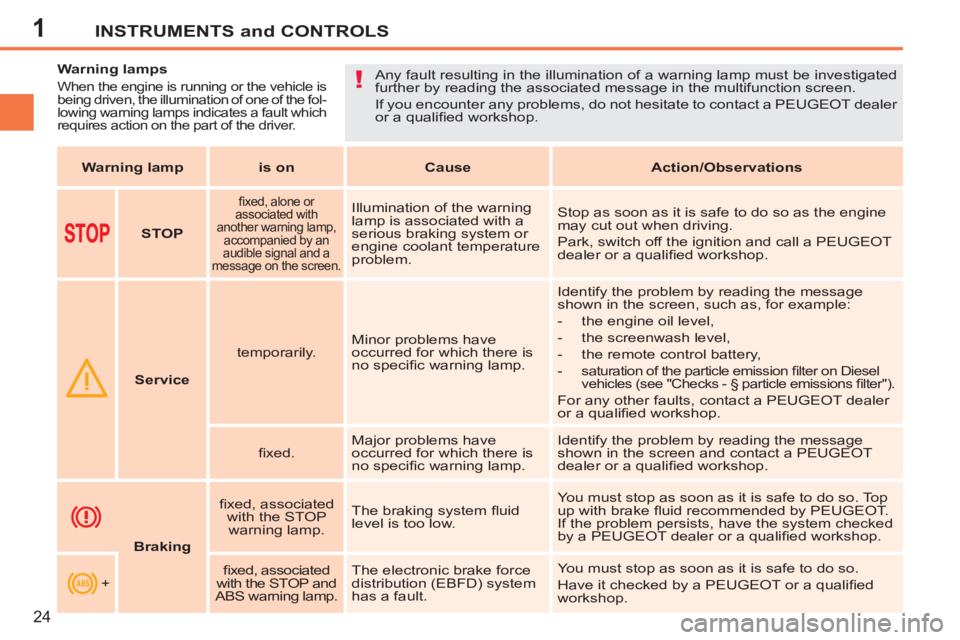
1
!
INSTRUMENTS and CONTROLS
24
Warning lamps
When the engine is running or the vehicle is
being driven, the illumination of one of the fol-
lowing warning lamps indicates a fault which
requires action on the part of the driver. Any fault resulting in the illumination of a warning lamp must be investigated
further by reading the associated message in the multifunction screen.
If you encounter any problems, do not hesitate to contact a PEUGEOT dealer
or a qualifi ed workshop.
Warning lamp
is on
Cause
Action/Observations
STOP
fi xed, alone or
associated with
another warning lamp,
accompanied by an
audible signal and a
message on the screen.
Illumination of the warning
lamp is associated with a
serious braking system or
engine coolant temperature
problem. Stop as soon as it is safe to do so as the engine
may cut out when driving.
Park, switch off the ignition and call a PEUGEOT
dealer or a qualifi ed workshop.
Service
temporarily. Minor problems have
occurred for which there is
no specifi c warning lamp. Identify the problem by reading the message
shown in the screen, such as, for example:
- the engine oil level,
- the screenwash level,
- the remote control battery,
-
saturation of the particle emission fi lter on Diesel
vehicles (see "Checks - § particle emissions fi lter").
For any other faults, contact a PEUGEOT dealer
or a qualifi ed workshop.
fi xed. Major problems have
occurred for which there is
no specifi c warning lamp. Identify the problem by reading the message
shown in the screen and contact a PEUGEOT
dealer or a qualifi ed workshop.
Braking
fi xed, associated
with the STOP
warning lamp. The braking system fl uid
level is too low. You must stop as soon as it is safe to do so. Top
up with brake fl uid recommended by PEUGEOT.
If the problem persists, have the system checked
by a PEUGEOT dealer or a qualifi ed workshop.
+
fi xed, associated
with the STOP and
ABS warning lamp. The electronic brake force
distribution (EBFD) system
has a fault. You must stop as soon as it is safe to do so.
Have it checked by a PEUGEOT or a qualifi ed
workshop.
Page 27 of 224
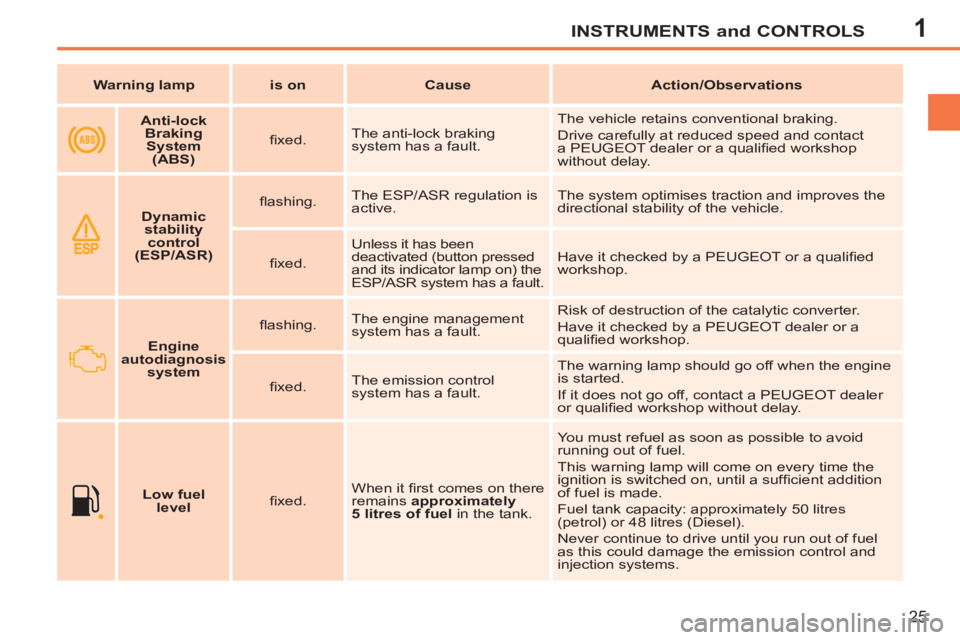
1INSTRUMENTS and CONTROLS
25
Warning lamp
is on
Cause
Action/Observations
Anti-lock
Braking
System
(ABS)
fi xed. The anti-lock braking
system has a fault. The vehicle retains conventional braking.
Drive carefully at reduced speed and contact
a PEUGEOT dealer or a qualifi ed workshop
without delay.
Dynamic
stability
control
(ESP/ASR)
fl ashing. The ESP/ASR regulation is
active. The system optimises traction and improves the
directional stability of the vehicle.
fi xed. Unless it has been
deactivated (button pressed
and its indicator lamp on) the
ESP/ASR system has a fault. Have it checked by a PEUGEOT or a qualifi ed
workshop.
Engine
autodiagnosis
system
fl ashing. The engine management
system has a fault. Risk of destruction of the catalytic converter.
Have it checked by a PEUGEOT dealer or a
qualifi ed workshop.
fi xed. The emission control
system has a fault. The warning lamp should go off when the engine
is started.
If it does not go off, contact a PEUGEOT dealer
or qualifi ed workshop without delay.
Low fuel
level
fi xed.
When it fi rst comes on there
remains approximately
5 litres of
fuel
in the tank. You must refuel as soon as possible to avoid
running out of fuel.
This warning lamp will come on every time the
ignition is switched on, until a suffi cient addition
of fuel is made.
Fuel tank capacity: approximately 50 litres
(petrol) or 48 litres (Diesel).
Never continue to drive until you run out of fuel
as this could damage the emission control and
injection systems.
Page 28 of 224
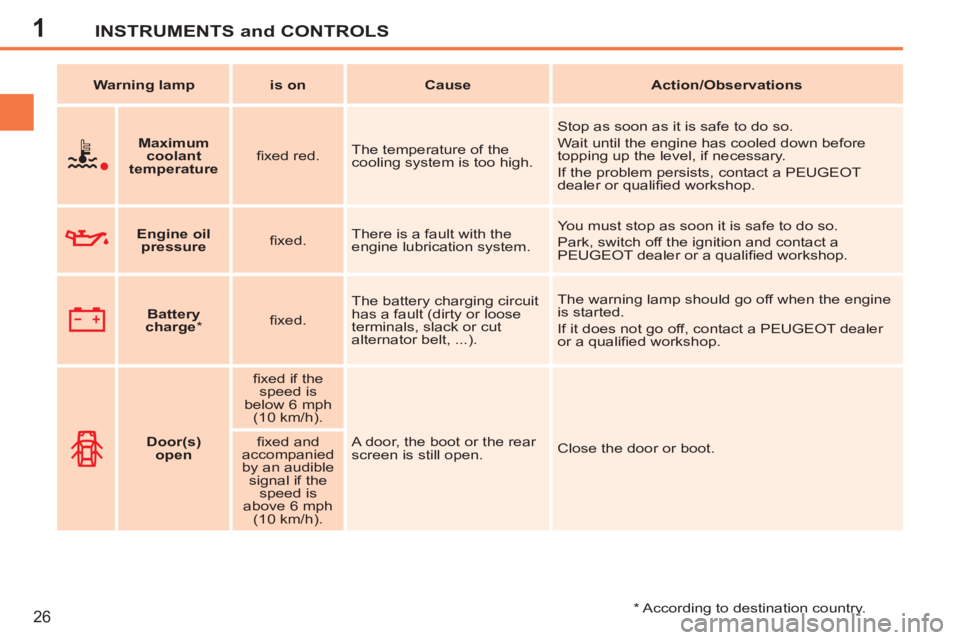
1INSTRUMENTS and CONTROLS
26
Warning lamp
is on
Cause
Action/Observations
Maximum
coolant
temperature
fi xed red. The temperature of the
cooling system is too high. Stop as soon as it is safe to do so.
Wait until the engine has cooled down before
topping up the level, if necessary.
If the problem persists, contact a PEUGEOT
dealer or qualifi ed workshop.
Engine oil
pressure
fi xed. There is a fault with the
engine lubrication system. You must stop as soon it is safe to do so.
Park, switch off the ignition and contact a
PEUGEOT dealer or a qualifi ed workshop.
Battery
charge
*
fi xed. The battery charging circuit
has a fault (dirty or loose
terminals, slack or cut
alternator belt, ...). The warning lamp should go off when the engine
is started.
If it does not go off, contact a PEUGEOT dealer
or a qualifi ed workshop.
Door(s)
open
fi xed if the
speed is
below 6 mph
(10 km/h).
A door, the boot or the rear
screen is still open. Close the door or boot.
fi xed and
accompanied
by an audible
signal if the
speed is
above 6 mph
(10 km/h).
*
According to destination country.
Page 29 of 224

1INSTRUMENTS and CONTROLS
Warning lamp
is on
Cause
Action/Observations
Airbags
temporarily. This lamp comes on for a
few seconds when you turn
on the ignition, then goes
off. This lamp should go off when the engine is
started.
If it does not go off, contact a PEUGEOT dealer
or a qualifi ed workshop.
fi xed. One of the airbag or seat
belt pretensioner systems
has a fault. Have it checked by a PEUGEOT dealer or a
qualifi ed workshop.
Seat belt not
fastened/
unfastened
fi xed then
fl ashing
accompanied
by an
increasing
audible signal. The driver and/or the front
passenger has not fastened
or has unfastened their seat
belt. Pull the strap then insert the tongue in the
buckle.
Power
steering
fi xed. The power steering has a
fault. Drive carefully at reduced speed.
Have it checked by a PEUGEOT dealer or a
qualifi ed workshop.
Water in
Diesel
fi xed. The Diesel fuel fi lter
contains water. Risk of damage to the injection system on Diesel
engines.
Contact a PEUGEOT dealer or a qualifi ed
workshop without delay.
Directional
headlamps
fl ashing. The directional headlamps
system has a fault. Have it checked by a PEUGEOT dealer or a
qualifi ed workshop.
Punctured
wheel
fi xed. One or more wheels are
punctured or seriously
defl ated. Stop immediately avoiding any sharp action on
the steering wheel or the brakes.
Repair or change the damaged wheel and have
the pressure of the tyres checked as soon as
possible.
Page 32 of 224

1
i
INSTRUMENTS and CONTROLS
30
The level shown will only be correct
if the vehicle is on level ground and
the engine has been off for more
than 30 minutes.
Engine oil level indicator
System which informs the driver whether
the engine oil level is correct or not.
This information is indicated for a few
seconds when the ignition is switched
on, after the service information.
Oil level correct
Oil level low
Oil level indicator fault
Dipstick
This is indicated by the fl ashing of
"OIL"
, linked with the service warning
lamp, accompanied by an audible sig-
nal and a message in the multifunction
screen.
If the low oil level is confi rmed by a
check using the dipstick, the level must
be topped up to prevent damage to the
engine. This is indicated by the fl ashing of
"OIL--"
. Contact a PEUGEOT dealer or
a qualifi ed workshop.
Refer to the "Checks" section to locate
the dipstick and the oil fi ller cap on your
engine.
There are 2 marks on the
dipstick:
- A
= max; never exceed
this level (risk of dam-
age to the engine),
- B
= min; top up the lev-
el via the oil fi ller cap,
using the grade of oil
suited to your engine.
Page 33 of 224
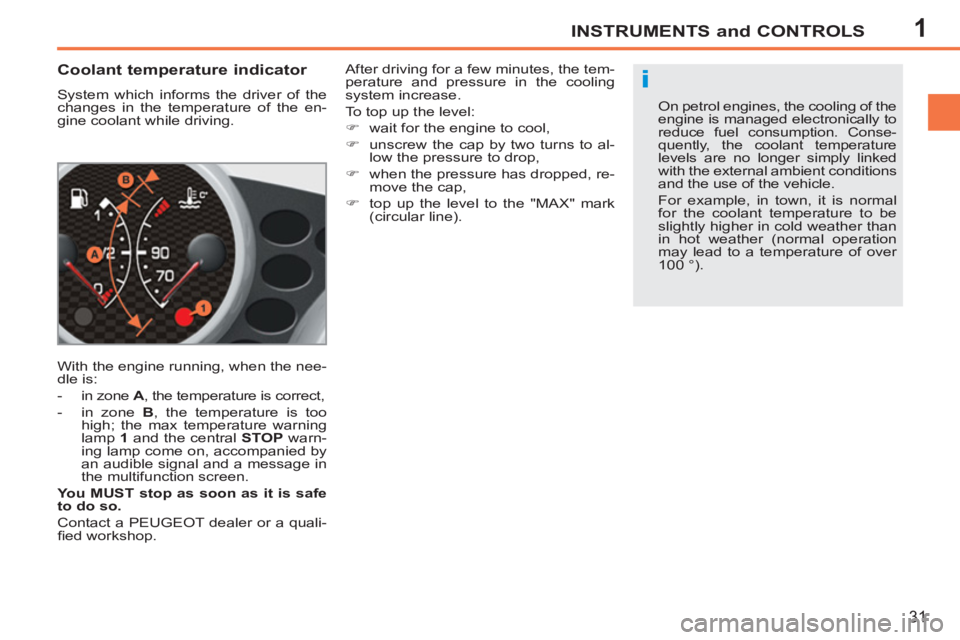
1
i
INSTRUMENTS and CONTROLS
31
Coolant temperature indicator
System which informs the driver of the
changes in the temperature of the en-
gine coolant while driving.
With the engine running, when the nee-
dle is:
- in zone A
, the temperature is correct,
- in zone B
, the temperature is too
high; the max temperature warning
lamp 1
and the central STOP
warn-
ing lamp come on, accompanied by
an audible signal and a message in
the multifunction screen.
You MUST stop as soon as it is safe
to do so.
Contact a PEUGEOT dealer or a quali-
fi ed workshop. After driving for a few minutes, the tem-
perature and pressure in the cooling
system increase.
To top up the level:
�)
wait for the engine to cool,
�)
unscrew the cap by two turns to al-
low the pressure to drop,
�)
when the pressure has dropped, re-
move the cap,
�)
top up the level to the "MAX" mark
(circular line). On petrol engines, the cooling of the
engine is managed electronically to
reduce fuel consumption. Conse-
quently, the coolant temperature
levels are no longer simply linked
with the external ambient conditions
and the use of the vehicle.
For example, in town, it is normal
for the coolant temperature to be
slightly higher in cold weather than
in hot weather (normal operation
may lead to a temperature of over
100 °).
Page 48 of 224

2
i
COMFORT
46
The air conditioning system does
not contain chlorine and does not
present any danger to the ozone
layer. RECOMMENDATIONS FOR VENTILATION AND AIR
CONDITIONING
In order for these systems to be fully effective, follow the operation and main-
tenance guidelines below:
�)
To obtain an even air distribution, take care not to obstruct the exterior air
intake grilles located at the base of the windscreen, the nozzles, the vents
and the air outlets, as well as the air extractor located in the boot.
�)
Do not cover the sunshine sensor, located on the dashboard; this is used
for regulation of the digital air conditioning system.
�)
Operate the air conditioning system for at least 5 to 10 minutes, once or
twice a month to keep it in perfect working order.
�)
Ensure that the passenger compartment fi lter is in good condition and
have the fi lter elements replaced regularly (refer to the "Checks" section).
We recommend the use of a combined passenger compartment fi lter.
Thanks to its special active additive, it contributes to the purifi cation of
the air breathed by the occupants and the cleanliness of the passenger
compartment (reduction of allergic symptoms, bad odours and greasy de-
posits).
�)
To ensure correct operation of the air conditioning system, you are also
advised to have it checked regularly as recommended in the servicing
booklet.
�)
If the system does not produce cold air, switch it off and contact a PEUGEOT
dealer or a qualifi ed workshop.
When towing the maximum load on a steep gradient in high temperatures,
switching off the air conditioning increases the available engine power and so
improves the towing ability.
If after an extended stop in sunshine, the interior temperature is very high, fi rst
ventilate the passenger compartment for a few moments.
Put the air fl ow control at a setting high enough to quickly change the air in the
passenger compartment.
The condensation created by the air conditioning results in a discharge of
water under the vehicle which is perfectly normal.
Page 50 of 224
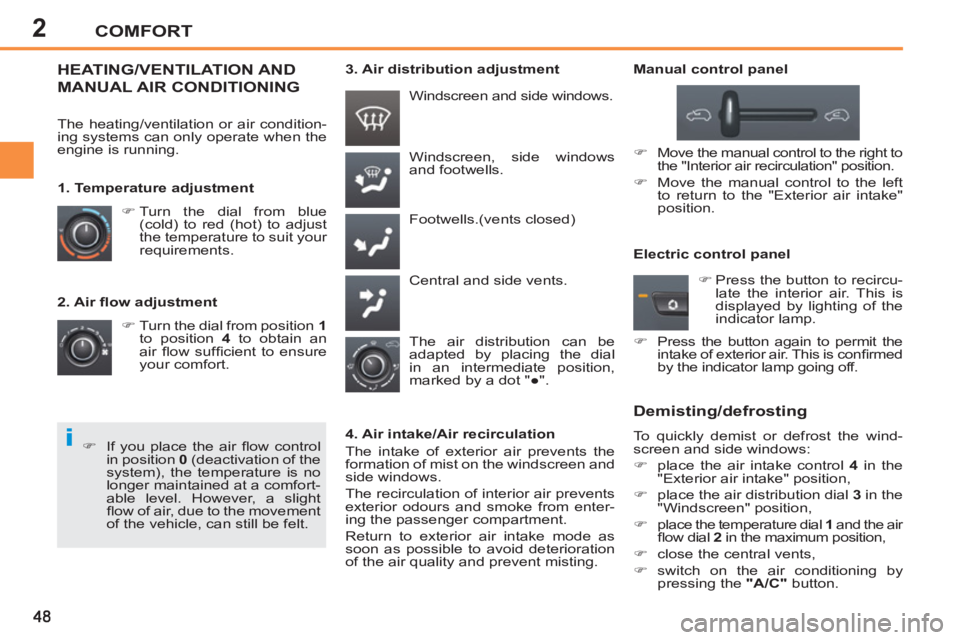
2
i
COMFORT
2. Air fl ow adjustment
�)
Turn the dial from position 1
to position 4
to obtain an
air fl ow suffi cient to ensure
your comfort. Windscreen, side windows
and footwells.
Footwells.(vents closed)
Central and side vents.
�)
Turn the dial from blue
(cold) to red (hot) to adjust
the temperature to suit your
requirements.
Windscreen and side windows.
1. Temperature adjustment
The air distribution can be
adapted by placing the dial
in an intermediate position,
marked by a dot "●". The heating/ventilation or air condition-
ing systems can only operate when the
engine is running.
HEATING/VENTILATION AND
MANUAL AIR CONDITIONING
Manual control panel
4. Air intake/Air recirculation
The intake of exterior air prevents the
formation of mist on the windscreen and
side windows.
The recirculation of interior air prevents
exterior odours and smoke from enter-
ing the passenger compartment.
Return to exterior air intake mode as
soon as possible to avoid deterioration
of the air quality and prevent misting.
Electric control panel
Demisting/defrosting
To quickly demist or defrost the wind-
screen and side windows:
�)
place the air intake control 4
in the
"Exterior air intake" position,
�)
place the air distribution dial 3
in the
"Windscreen" position,
�)
place the temperature dial 1
and the air
fl ow dial 2
in the maximum position,
�)
close the central vents,
�)
switch on the air conditioning by
pressing the "A/C"
button.
�)
If you place the air fl ow control
in position 0
(deactivation of the
system), the temperature is no
longer maintained at a comfort-
able level. However, a slight
fl ow of air, due to the movement
of the vehicle, can still be felt.
3. Air distribution adjustment
�)
Move the manual control to the right to
the "Interior air recirculation" position.
�)
Move the manual control to the left
to return to the "Exterior air intake"
position.
�)
Press the button to recircu-
late the interior air. This is
displayed by lighting of the
indicator lamp.
�)
Press the button again to permit the
intake of exterior air. This is confi rmed
by the indicator lamp going off.
Page 51 of 224
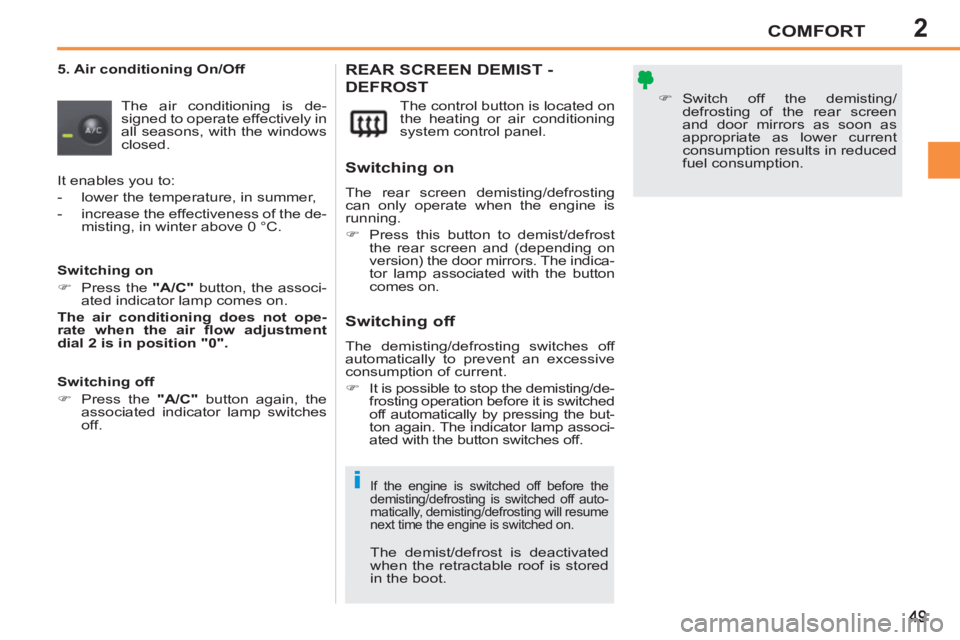
2
i
COMFORT
5. Air conditioning On/Off
The air conditioning is de-
signed to operate effectively in
all seasons, with the windows
closed. The control button is located on
the heating or air conditioning
system control panel. REAR SCREEN DEMIST -
DEFROST
�)
Switch off the demisting/
defrosting of the rear screen
and door mirrors as soon as
appropriate as lower current
consumption results in reduced
fuel consumption.
If the engine is switched off before the
demisting/defrosting is switched off auto-
matically, demisting/defrosting will resume
next time the engine is switched on.
Switching on
The rear screen demisting/defrosting
can only operate when the engine is
running.
�)
Press this button to demist/defrost
the rear screen and (depending on
version) the door mirrors. The indica-
tor lamp associated with the button
comes on.
Switching off
The demisting/defrosting switches off
automatically to prevent an excessive
consumption of current.
�)
It is possible to stop the demisting/de-
frosting operation before it is switched
off automatically by pressing the but-
ton again. The indicator lamp associ-
ated with the button switches off. It enables you to:
- lower the temperature, in summer,
- increase the effectiveness of the de-
misting, in winter above 0 °C.
Switching on
�)
Press the "A/C"
button, the associ-
ated indicator lamp comes on.
The air conditioning does not ope-
rate when the air fl ow adjustment
dial 2 is in position "0".
Switching off
�)
Press the "A/C"
button again, the
associated indicator lamp switches
off.
The demist/defrost is deactivated
when the retractable roof is stored
in the boot.
Page 52 of 224
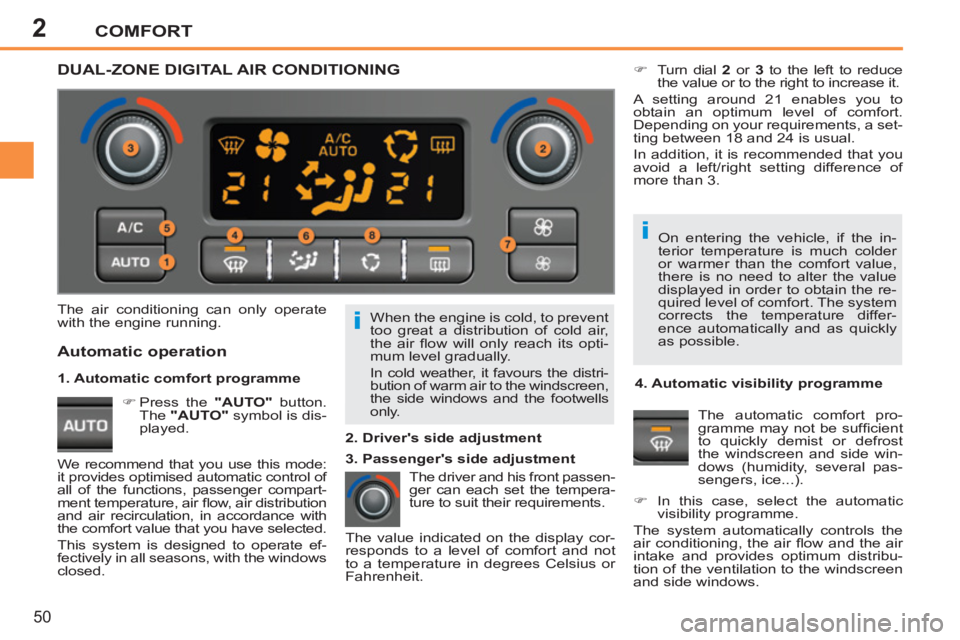
2
i
i
COMFORT
50
When the engine is cold, to prevent
too great a distribution of cold air,
the air fl ow will only reach its opti-
mum level gradually.
In cold weather, it favours the distri-
bution of warm air to the windscreen,
the side windows and the footwells
only. On entering the vehicle, if the in-
terior temperature is much colder
or warmer than the comfort value,
there is no need to alter the value
displayed in order to obtain the re-
quired level of comfort. The system
corrects the temperature differ-
ence automatically and as quickly
as possible.
The air conditioning can only operate
with the engine running.
The driver and his front passen-
ger can each set the tempera-
ture to suit their requirements.
�)
Turn dial 2
or 3
to the left to reduce
the value or to the right to increase it.
A setting around 21 enables you to
obtain an optimum level of comfort.
Depending on your requirements, a set-
ting between 18 and 24 is usual.
In addition, it is recommended that you
avoid a left/right setting difference of
more than 3.
4. Automatic visibility programme
The automatic comfort pro-
gramme may not be suffi cient
to quickly demist or defrost
the windscreen and side win-
dows (humidity, several pas-
sengers, ice...).
�)
In this case, select the automatic
visibility programme.
The system automatically controls the
air conditioning, the air fl ow and the air
intake and provides optimum distribu-
tion of the ventilation to the windscreen
and side windows.
Automatic operation
�)
Press the "AUTO"
button.
The "AUTO"
symbol is dis-
played.
2. Driver's side adjustment
DUAL-ZONE DIGITAL AIR CONDITIONING
We recommend that you use this mode:
it provides optimised automatic control of
all of the functions, passenger compart-
ment temperature, air fl ow, air distribution
and air recirculation, in accordance with
the comfort value that you have selected.
This system is designed to operate ef-
fectively in all seasons, with the windows
closed. The value indicated on the display cor-
responds to a level of comfort and not
to a temperature in degrees Celsius or
Fahrenheit.
1. Automatic comfort programme
3. Passenger's side adjustment